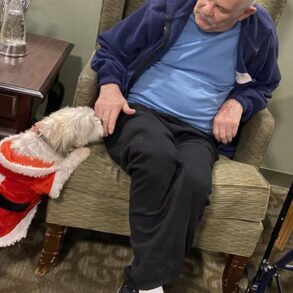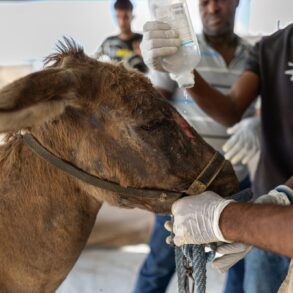Decemberr 25, 2024 – Happy holidays? Not if your pet gets sick. The Food and Drug Administration’s Center for Veterinary Medicine discusses some unhealthy holiday temptations and how to keep your pets safe.
Stocking Stuffers and Pet Treats
If your dog received a stocking full of pet treats, make sure he doesn’t gobble them all up at once, making them hard to digest. Unchewed pet treats can get stuck in the trachea (windpipe) or gastrointestinal tract (esophagus, stomach, and intestines).
If your dog is in obvious distress from eating too much too fast, call your veterinarian immediately. Some telltale signs are drooling, choking, or vomiting.
Take note of timing. If a bone or chew toy lodges in your dog’s stomach or intestines, the symptoms might not be immediate. Hours to days later, he may vomit and have diarrhea, be less active, not want to eat, and have stomach pain. If the blockage stays there too long, your dog may become very ill.
When in doubt, call your veterinarian, who may need to take x-rays, use an endoscope (a medical device with a special camera that can see inside the throat, stomach, and intestines), or even do abdominal surgery to see what and where the problem is and remove any pieces of bone or chew toy that are causing the blockage.
Tinsel and Ribbons
Decorating your tree? Wrapping or unwrapping gifts? Keep a close eye on where you leave leftover tinsel, string, and ribbons.
Your cat or dog may find these decorations irresistible because they look like easy-to-catch, sparkly, and wiggly prey. In fact, they can cause serious stomach and intestinal damage.
Play it safe by keeping tinsel off the tree and collecting all ribbons and string after gifts are opened.

Salt-Dough Ornaments and Homemade Play Dough
If you’re making salt-dough ornaments or homemade play dough, keep your pets away from them. They contain a great deal of salt, which can be fatal to pets if eaten. Be sure to warn children who may want to give a “treat” to Bowser or Kiki. Putting it in perspective, one cup of salt is 48 teaspoons. A 10-pound pet can get sick after eating just ½ teaspoon of table salt, and 1 ½ teaspoons of salt can be fatal.
Holiday Plants
If you have holiday plants such as poinsettias, mistletoe, or holly around, take care. When you display (or dispose of) these plants, your cat or dog may decide they’re good to eat.
Take poinsettias, which can irritate your pet’s mouth and stomach and may cause drooling, vomiting, and diarrhea. If your pet eats poinsettia leaves, you can help by picking up the food and water dishes for a couple of hours to let your pet’s stomach settle.
Fortunately, severe mistletoe toxicity is uncommon and usually occurs only if your pet eats a large amount. Symptoms include vomiting and diarrhea, difficulty breathing, slowed heart rate, low blood pressure, and odd behavior.
Even though holly berries and leaves aren’t very harmful, they can still make your pet ill and you should prevent your pets from eating them. In both dogs and cats, the plant’s toxins can cause drooling, vomiting, diarrhea, loss of appetite, and decreased activity. Not to mention, the spikey leaves could hurt your pet’s mouth.
You can read more about what houseplants may be dangerous to your pets at ASPCA Poisonous Plants (External Link Disclaimer).
Table Scraps
Don’t give your pet table scraps that are high in fat, such as fat trimmings from meat or skin from a roasted turkey or chicken. Not only can rich foods cause an upset stomach, but they can also cause a potentially life-threatening and painful disease called pancreatitis. The most common symptoms of pancreatitis in dogs include vomiting, stomach pain, restlessness, shaking, diarrhea, fever, and weakness.
In cats, the symptoms are less clear and harder to notice, such as decreased appetite and weight loss.
And be careful what you put in the trash can. Dogs, especially, are notorious for helping themselves to the turkey carcass or steak bones, which can get stuck in your dog’s esophagus, stomach, or trachea. Sharp pieces of bones can also injure your dog’s mouth, esophagus, and stomach, and can cause severe internal injuries. Once your holiday meal is done, securely wrap up the table scraps and bones and dispose of them in a trash bin that your pets can’t get into.
Other Human Treats, Including Alcohol
You may know that eating chocolate can be dangerous to your dog or cat. But that’s not the only thing.
For instance, the seemingly harmless mints common in the holiday season can cause life-threatening problems for your dog if they contain xylitol, also found in food items, such as candy, chewing gum, some peanut butters, and baked goods, and personal hygiene products, such as toothpaste and mouthwash.
Symptoms occur quickly after dogs eat items containing xylitol. Vomiting is generally first, followed by symptoms associated with the sudden lowering of your dog’s blood sugar (hypoglycemia), such as decreased activity, weakness, staggering, incoordination, collapse, and seizures. Check the package label to see if the product contains xylitol and call your veterinarian immediately if it does.
As for eating chocolate, some pets develop severe complications, including liver failure, bleeding disorders, and death. Unsweetened or baking chocolate is especially dangerous to pets because it has the highest concentration of the ingredient that’s toxic to pets. As with xylitol, if you suspect your dog has eaten chocolate, consider it an emergency and call your veterinarian immediately.
And keep your pets away from alcohol, which can cause serious problems. The most common symptoms are vomiting, diarrhea, incoordination, weakness, decreased activity, difficulty breathing, and shaking. In severe cases, coma and death from respiratory failure (lungs stop functioning) can occur.
Food and Snack Bags
Snacks are everywhere during the holidays.
Food bags, especially the mylar-type potato chip, cereal, and snack bags, can be dangerous for your pets. With their good noses, dogs in particular are apt to sniff them out. These bags are thin enough that if a dog puts his head far enough into one and breathes in, the bag can wrap around his nose and mouth, suffocating him. Make sure that snack bags are closed and put away in a cabinet or, if empty, tossed into a trash bin that your pets can’t get into.
View YouTube video here.
Source & photo: FDA
This post was originally published on this site be sure to check out more of their content.










































